Google Nexus 7 Review (2013)
At one time, the Google Nexus 7 tablet, created in collaboration with ASUS, became Google’s official debut on the tablet market. The first version of the device, due to its technical advantages, high quality manufacturing and a fairly low price won a serious market share of 7-inch tablets. In the (now) past, 2013, an updated version was released: Nexus 7 (2013).
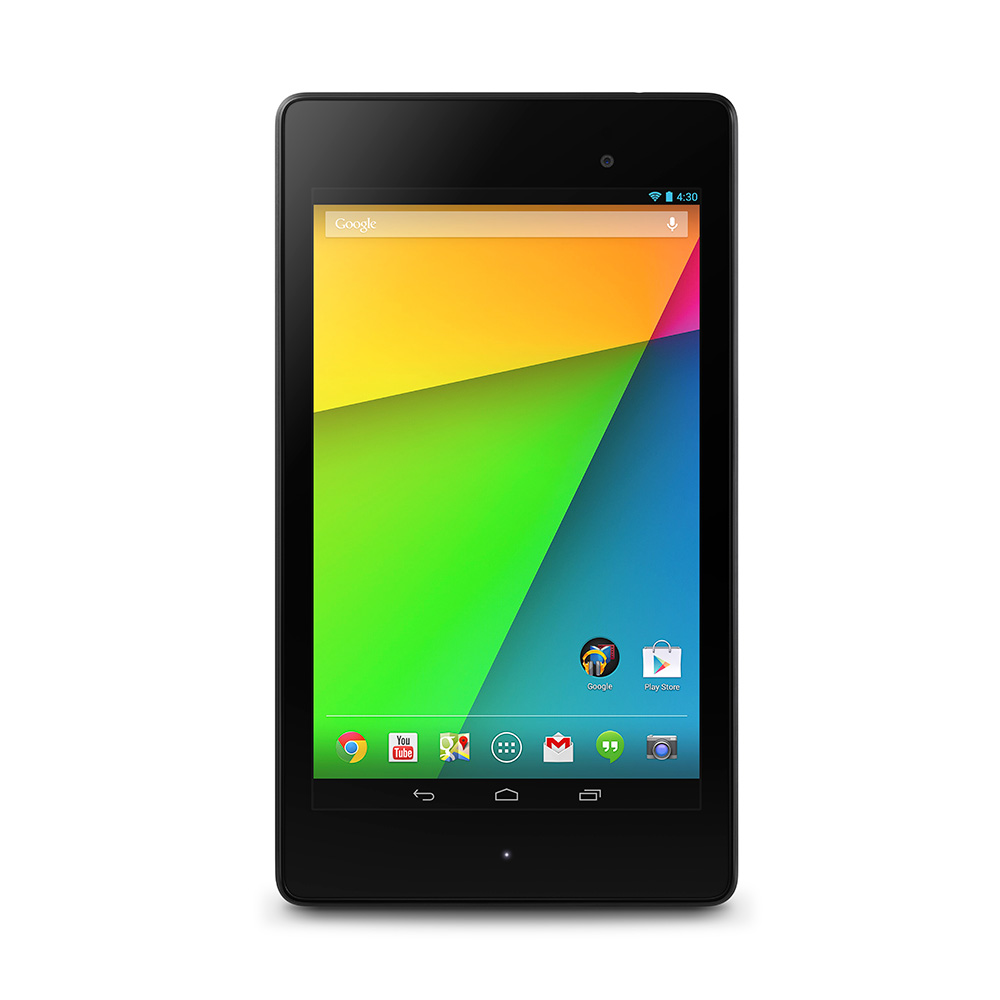
Ahead of attentive habriters, we will explain that yes, the device came out last year, but the tablet continues to be in the sales tops, so we decided to do a detailed and detailed review in our blog.
In the technical specifications below, the data in the first Nexus 7 version will be shown in square brackets.
OS: Android 4.4 [4.1]
Screen: 7 "LED Backlight WUXGA (1920x1200) [1280x800], IPS, with multitouch support
Processor: Qualcomm® Snapdragon ™ S4 Pro 8064 Quad-Core, 1.5 GHz [NVIDIA® Tegra3 ™ Quad-Core, 1.2 GHz]
Graphics: Adreno 320
RAM: 2 GB [1 GB]
Memory: 16 GB
Wireless communication: WLAN 802.11 a / b / g / n @ 2.4 / 5 GHz [WLAN 802.11 b/g/n@2.4GHz]
Bluetooth V4.0 [V3.0]
NFC
Cellular communication: LTE / DC –HSPA + / EDGE for the version equipped with a cellular communication module
Camera:
1.2 megapixel front, with autofocus
5 megapixel main, with autofocus, f2.4 aperture [absent]
Sound: stereo speakers
Connectors:
1 x microUSB
1 x audio
Sensors:
Accelerometer
Compass
Light sensor
Gyroscope
Hall Sensor
Battery: 15 [16] W * hour, Li-Po
Navigation: GPS, GLONASS
Power Supply:
Outgoing: 5.2 V, 1.35 A, 7W
Input: 100-240 VAC, 50/60 Hz
Wireless charging support
Dimensions: 200 x 114 x 8.65 mm (Length x Width x Thickness) [198.5 x 120 x 10.45]
Weight: 290/299 (model with 4G module) [340] g
')

Nexus 7 (2013) comes in the usual austere configuration: in addition to the USB cable and a miniature charger, there is nothing in the box.
The front side of the tablet looks traditional, there is not even a logo, only an inconspicuous eye of the front camera.
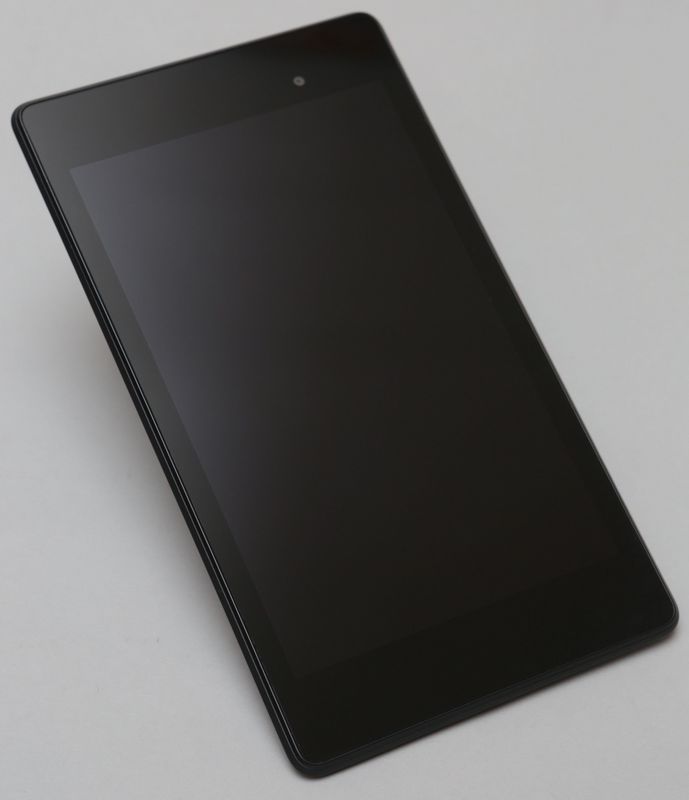

In the new version of the Nexus 7, the developers abandoned the characteristic dotted texture, now the back side is made of a smooth matte soft-touch plastic, in the center is a large NEXUS logo. On top and bottom are the stereo speaker grilles, and in the upper left corner is the main camera.

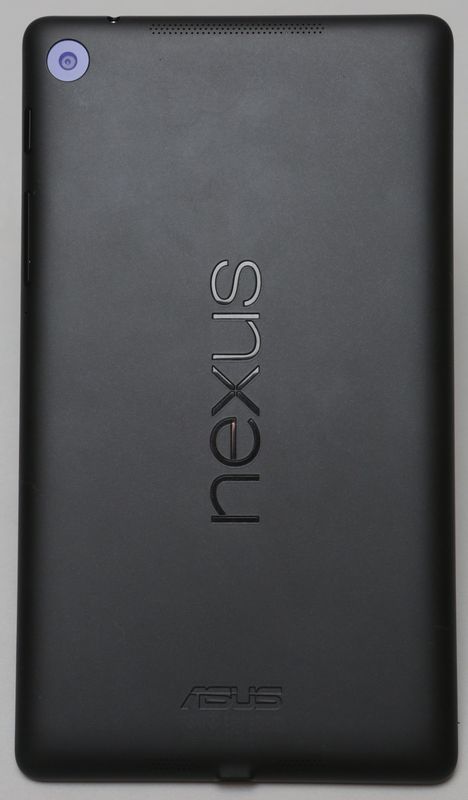
On the right side, if the tablet is oriented in portrait, there are buttons for turning on and adjusting the sound.

At the top is an audio jack.

At the bottom is the microUSB port.

The location of the front camera, the power and volume buttons mean that working with the tablet involves mostly portrait orientation.
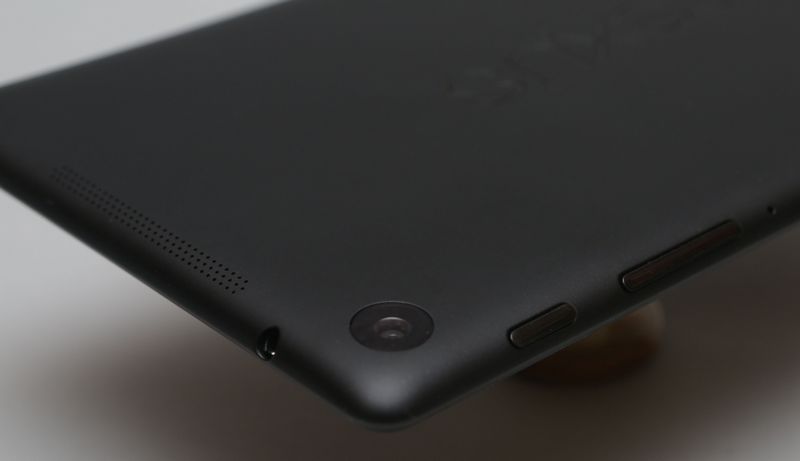
At the same time, stereo speakers are separated from each other taking into account landscape orientation for watching videos and games.

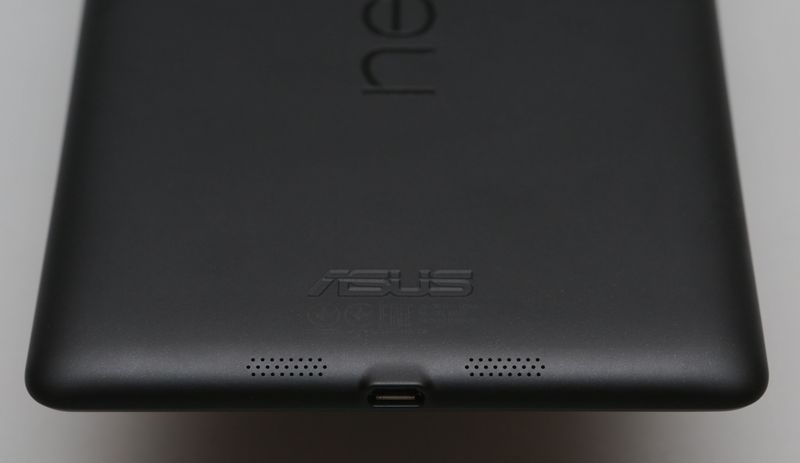
The body of the tablet is large enough, so control with one hand is not always convenient. I have a medium-sized hand, and I no longer manage to reach the opposite edge of the screen with my thumb. Although the weight of the device does not create discomfort with the “one-handed grip,” but with active surfing you often have to resort to using a second hand.
The most noticeable, in every sense of the word, the distinction of Nexus 7 (2013) was the high-quality screen, covered with Gorilla Glass. The new version is equipped with an excellent screen with a resolution of 1920x1200 instead of 1280x800, as in the first model. With a diagonal of 7 inches, the resolution is now 323 ppi. I, no matter how hard I tried, could not notice the gradations on the curves and inclined lines, the image looks perfectly clear and smooth.
The color rendition of the Nexus 7 (2013), according to the impressions of the subjective comparison, is the best of all the smartphones and tablets I have reviewed to date.
The brightness margin is quite large. I compared on this parameter completely different devices: our hero, ASUS Fonepad Note 6 and ASUS Transformer Pad (TF701T). On all devices, the power saving function was turned off, and at a level of 30% the brightness of the Nexus 7 (2013) screen was higher than that of two others at a level of 50%.
The speakers do not have a remarkable sound quality. Quite expected lack of low frequencies. The rest of the sound is quite balanced. The situation is greatly improved when using headphones.
Unfortunately, the version without the mobile communication module MDM9215M got into the review, so it was not possible to assess the quality of communication.
The tablet comes with a number of pre-installed additional applications from Google: Google Drive (cloud storage), Google Calendar, Google Media (aggregator of electronic media and news feeds), Google Chrome, Google Keep (program for notes), Google Photos (processing and downloading photos on Google+).
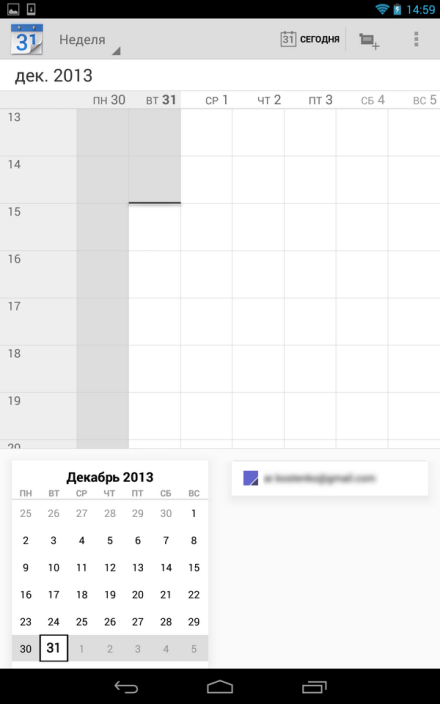

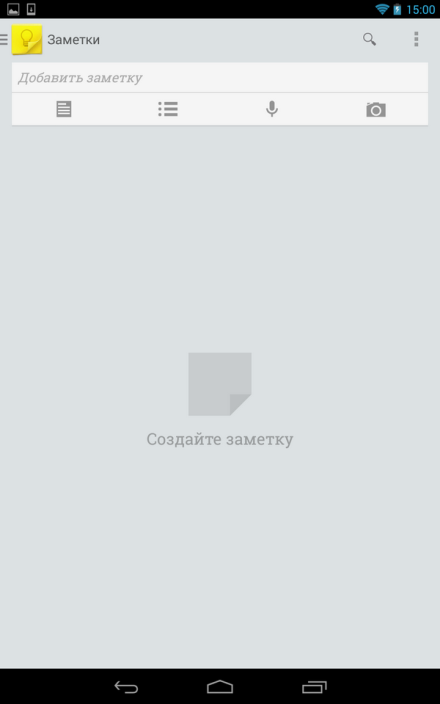
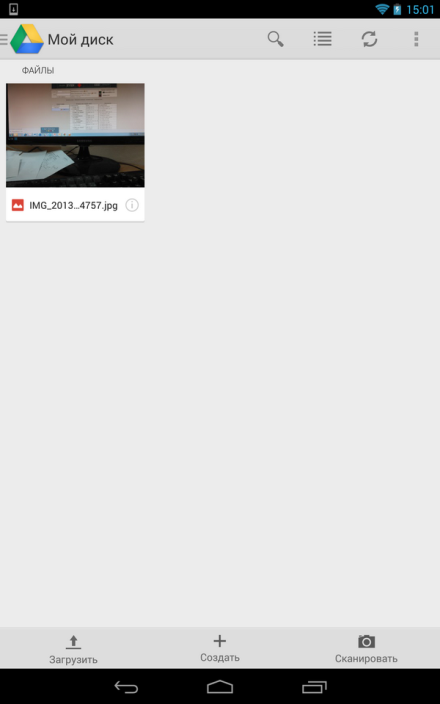
The shell of the operating system itself has a more ascetic design compared to the old version of Android:
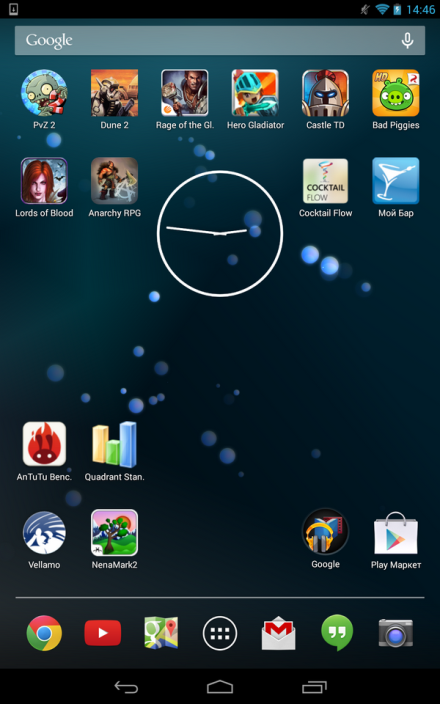


The Google search bar is pass-through for all desktops.
Nexus 7 (2013) does not have a built-in flash, so when the light level is low, the matrix has to squeeze everything out of itself. Or maybe it is, alas, a bit: the sensitivity of the matrix is small, and the noise in the photographs are present in large numbers.
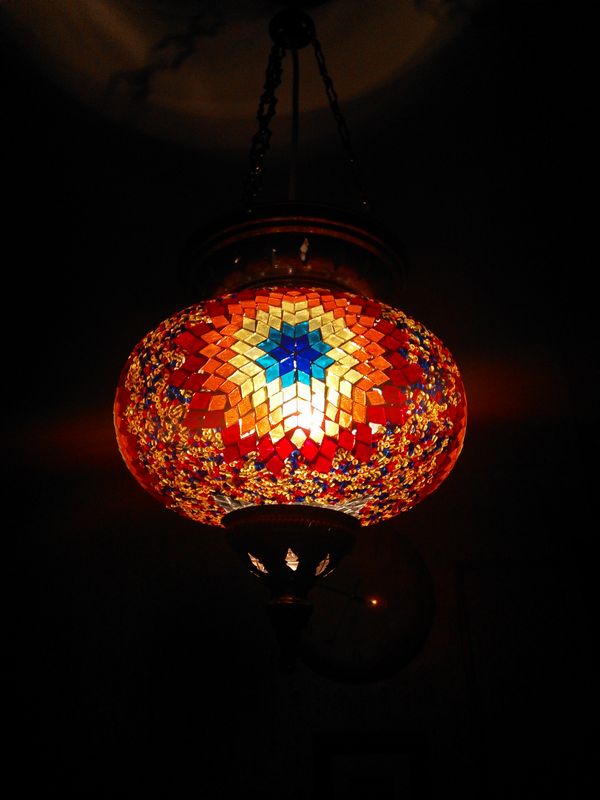
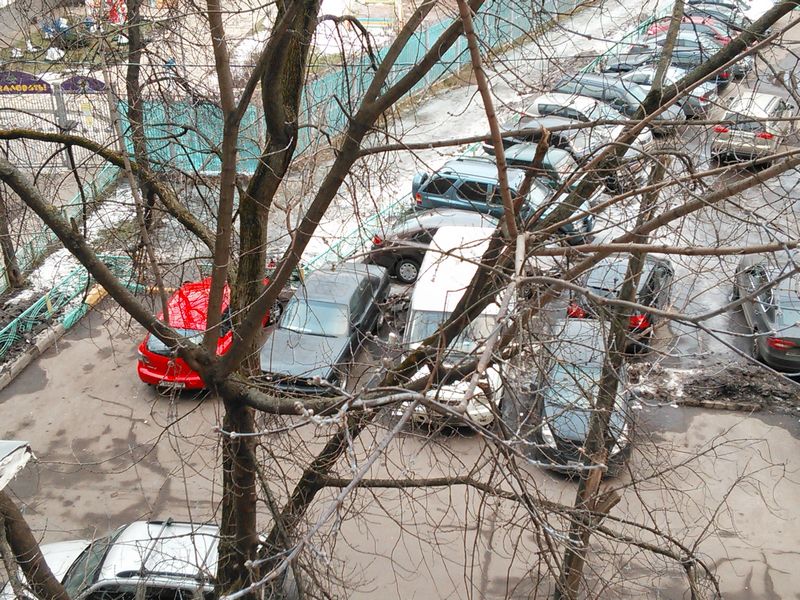

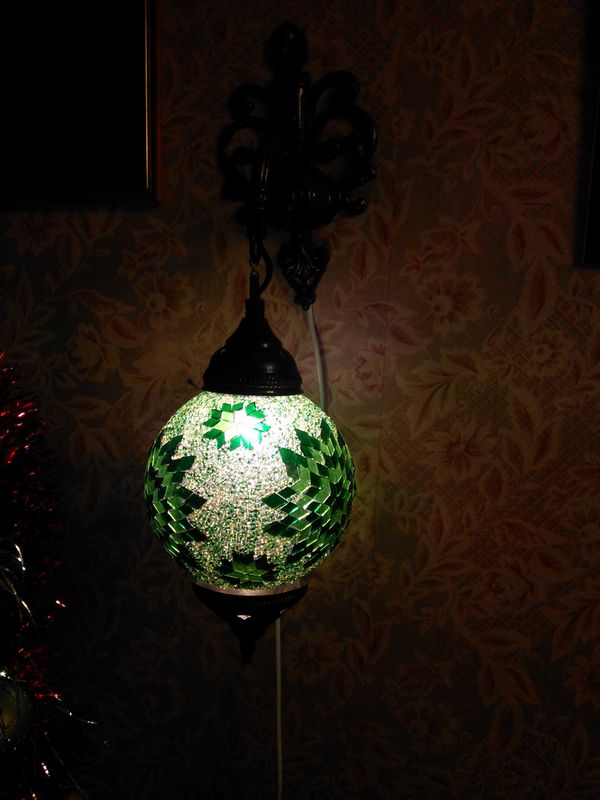



Another innovation was the possibility of wireless charging. To do this, you must purchase a special stand-charger:
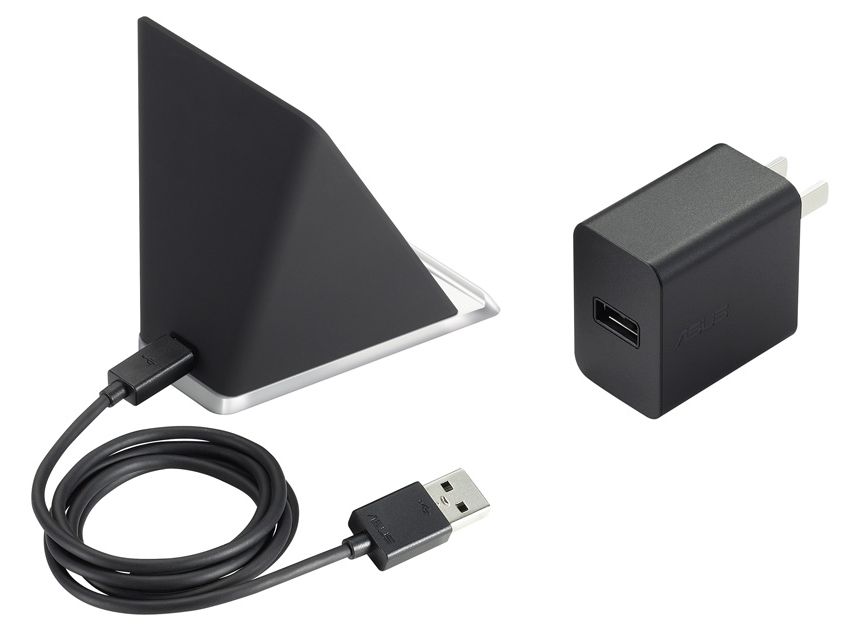
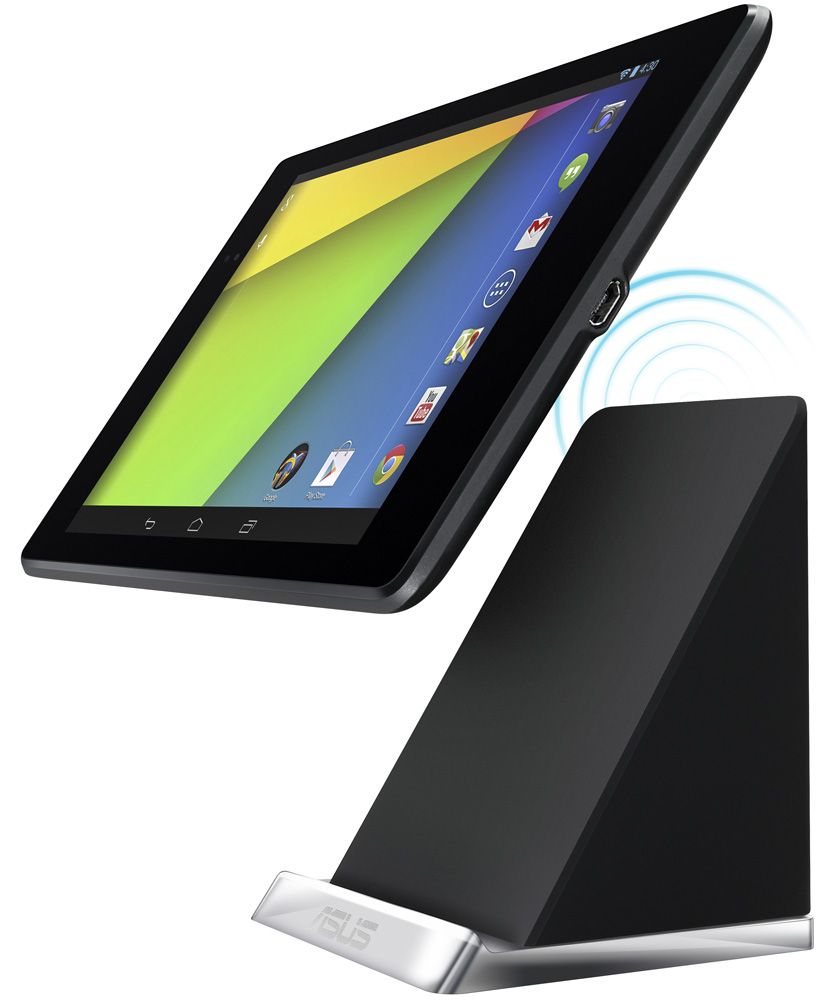
Unfortunately, I did not have the opportunity to test this accessory, so I can not say anything about the speed of charging the battery with it.
The tablet works very quickly, no brakes, loading applications does not last long. Switching between screens also occurs without annoying slowness.
Benchmark results:


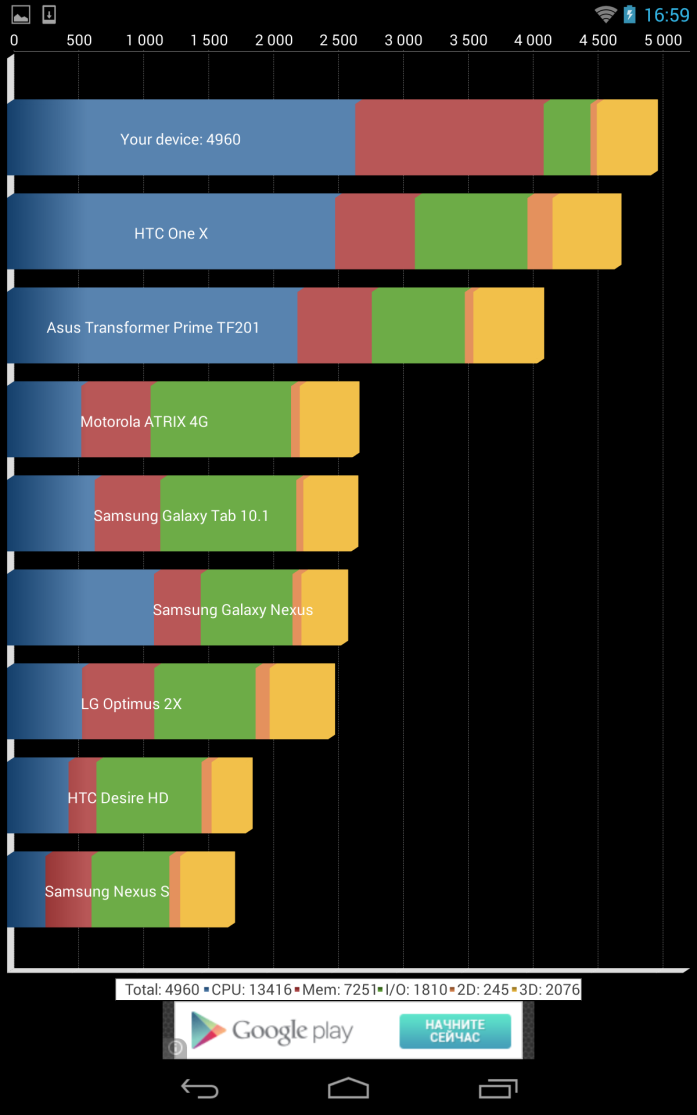
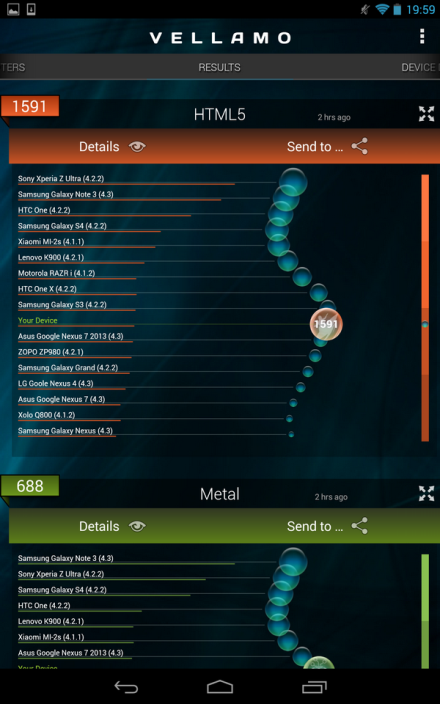

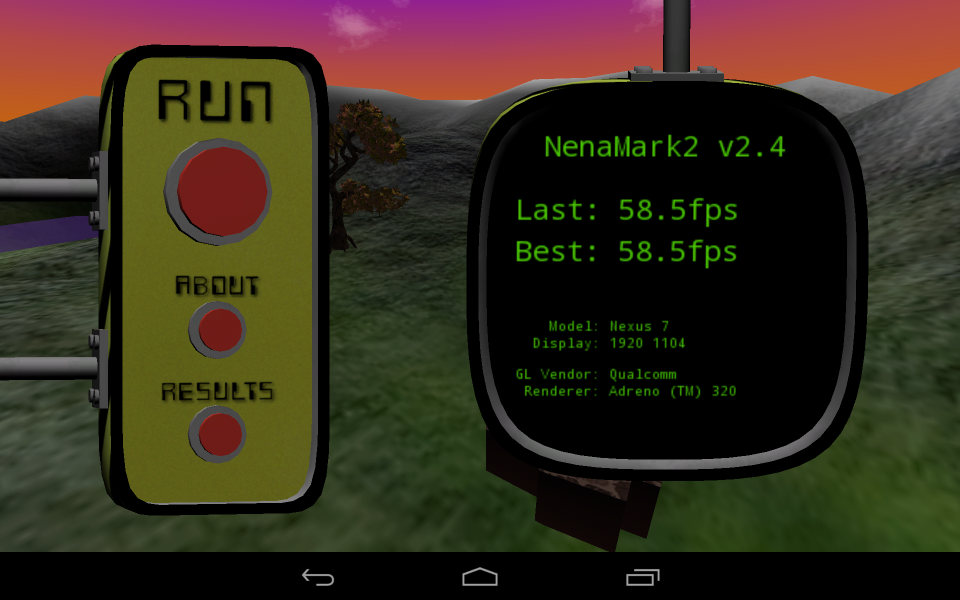
Surfing the Internet via WiFi, with periodic video views on Youtube and listening to background music, with a screen brightness of 30%: 13 hours 30 minutes.
View FullHD (1920 * 1200) movies with a screen brightness of 30%: 8 hours and 40 minutes.
In my opinion, Nexus 7 (2013) is one of the best mini-tablets with a screen diagonal of 7 inches. Its indisputable advantages are the screen with a resolution of 1920x1080, covered with Gorilla Glass, high screen brightness, excellent color reproduction, high performance, long battery life, low weight and the possibility of wireless charging. The disadvantages can be low quality photography. But if for you it is irrelevant, then I strongly advise you to look at this device. Both performance and screen size allow the Nexus 7 (2013) in many cases to be an excellent substitute for full-sized tablets, while winning in size and weight of the device.
Recommended retail price: 9990 rubles in this configuration / 15990 rubles in the configuration with 4G module.

Ahead of attentive habriters, we will explain that yes, the device came out last year, but the tablet continues to be in the sales tops, so we decided to do a detailed and detailed review in our blog.
Specifications
In the technical specifications below, the data in the first Nexus 7 version will be shown in square brackets.
OS: Android 4.4 [4.1]
Screen: 7 "LED Backlight WUXGA (1920x1200) [1280x800], IPS, with multitouch support
Processor: Qualcomm® Snapdragon ™ S4 Pro 8064 Quad-Core, 1.5 GHz [NVIDIA® Tegra3 ™ Quad-Core, 1.2 GHz]
Graphics: Adreno 320
RAM: 2 GB [1 GB]
Memory: 16 GB
Wireless communication: WLAN 802.11 a / b / g / n @ 2.4 / 5 GHz [WLAN 802.11 b/g/n@2.4GHz]
Bluetooth V4.0 [V3.0]
NFC
Cellular communication: LTE / DC –HSPA + / EDGE for the version equipped with a cellular communication module
Camera:
1.2 megapixel front, with autofocus
5 megapixel main, with autofocus, f2.4 aperture [absent]
Sound: stereo speakers
Connectors:
1 x microUSB
1 x audio
Sensors:
Accelerometer
Compass
Light sensor
Gyroscope
Hall Sensor
Battery: 15 [16] W * hour, Li-Po
Navigation: GPS, GLONASS
Power Supply:
Outgoing: 5.2 V, 1.35 A, 7W
Input: 100-240 VAC, 50/60 Hz
Wireless charging support
Dimensions: 200 x 114 x 8.65 mm (Length x Width x Thickness) [198.5 x 120 x 10.45]
Weight: 290/299 (model with 4G module) [340] g
')

Complete set and appearance
Nexus 7 (2013) comes in the usual austere configuration: in addition to the USB cable and a miniature charger, there is nothing in the box.
The front side of the tablet looks traditional, there is not even a logo, only an inconspicuous eye of the front camera.


In the new version of the Nexus 7, the developers abandoned the characteristic dotted texture, now the back side is made of a smooth matte soft-touch plastic, in the center is a large NEXUS logo. On top and bottom are the stereo speaker grilles, and in the upper left corner is the main camera.


On the right side, if the tablet is oriented in portrait, there are buttons for turning on and adjusting the sound.

At the top is an audio jack.

At the bottom is the microUSB port.

The location of the front camera, the power and volume buttons mean that working with the tablet involves mostly portrait orientation.

At the same time, stereo speakers are separated from each other taking into account landscape orientation for watching videos and games.


The body of the tablet is large enough, so control with one hand is not always convenient. I have a medium-sized hand, and I no longer manage to reach the opposite edge of the screen with my thumb. Although the weight of the device does not create discomfort with the “one-handed grip,” but with active surfing you often have to resort to using a second hand.
Screen
The most noticeable, in every sense of the word, the distinction of Nexus 7 (2013) was the high-quality screen, covered with Gorilla Glass. The new version is equipped with an excellent screen with a resolution of 1920x1200 instead of 1280x800, as in the first model. With a diagonal of 7 inches, the resolution is now 323 ppi. I, no matter how hard I tried, could not notice the gradations on the curves and inclined lines, the image looks perfectly clear and smooth.
The color rendition of the Nexus 7 (2013), according to the impressions of the subjective comparison, is the best of all the smartphones and tablets I have reviewed to date.
The brightness margin is quite large. I compared on this parameter completely different devices: our hero, ASUS Fonepad Note 6 and ASUS Transformer Pad (TF701T). On all devices, the power saving function was turned off, and at a level of 30% the brightness of the Nexus 7 (2013) screen was higher than that of two others at a level of 50%.
Sound
The speakers do not have a remarkable sound quality. Quite expected lack of low frequencies. The rest of the sound is quite balanced. The situation is greatly improved when using headphones.
cellular
Unfortunately, the version without the mobile communication module MDM9215M got into the review, so it was not possible to assess the quality of communication.
Software
The tablet comes with a number of pre-installed additional applications from Google: Google Drive (cloud storage), Google Calendar, Google Media (aggregator of electronic media and news feeds), Google Chrome, Google Keep (program for notes), Google Photos (processing and downloading photos on Google+).




The shell of the operating system itself has a more ascetic design compared to the old version of Android:



The Google search bar is pass-through for all desktops.
Camera
Nexus 7 (2013) does not have a built-in flash, so when the light level is low, the matrix has to squeeze everything out of itself. Or maybe it is, alas, a bit: the sensitivity of the matrix is small, and the noise in the photographs are present in large numbers.







Wireless charger
Another innovation was the possibility of wireless charging. To do this, you must purchase a special stand-charger:


Unfortunately, I did not have the opportunity to test this accessory, so I can not say anything about the speed of charging the battery with it.
Performance
The tablet works very quickly, no brakes, loading applications does not last long. Switching between screens also occurs without annoying slowness.
Benchmark results:






Duration of work
Surfing the Internet via WiFi, with periodic video views on Youtube and listening to background music, with a screen brightness of 30%: 13 hours 30 minutes.
View FullHD (1920 * 1200) movies with a screen brightness of 30%: 8 hours and 40 minutes.
Conclusion
In my opinion, Nexus 7 (2013) is one of the best mini-tablets with a screen diagonal of 7 inches. Its indisputable advantages are the screen with a resolution of 1920x1080, covered with Gorilla Glass, high screen brightness, excellent color reproduction, high performance, long battery life, low weight and the possibility of wireless charging. The disadvantages can be low quality photography. But if for you it is irrelevant, then I strongly advise you to look at this device. Both performance and screen size allow the Nexus 7 (2013) in many cases to be an excellent substitute for full-sized tablets, while winning in size and weight of the device.
Recommended retail price: 9990 rubles in this configuration / 15990 rubles in the configuration with 4G module.
Source: https://habr.com/ru/post/209180/
All Articles